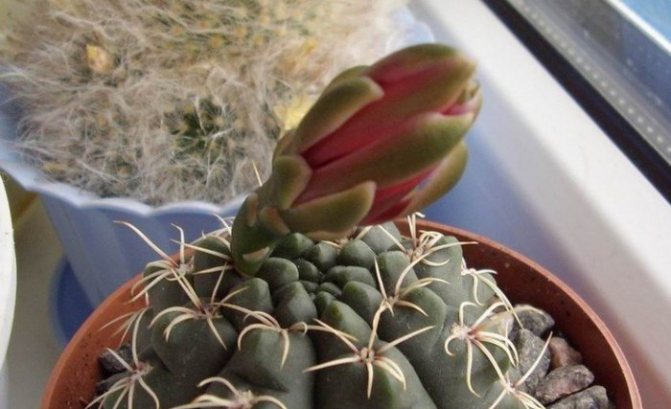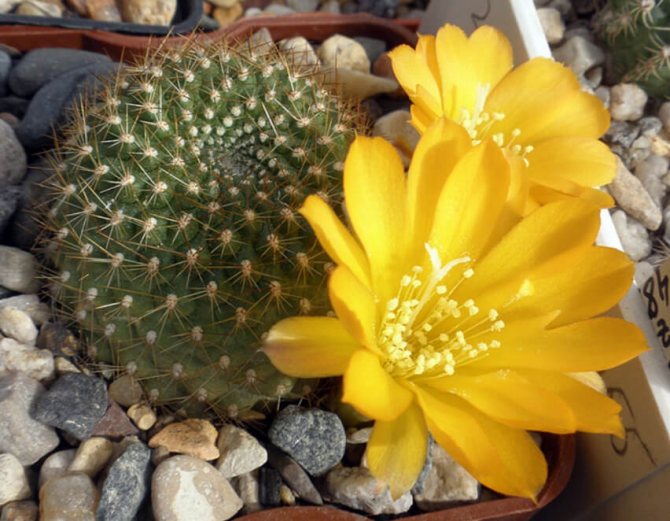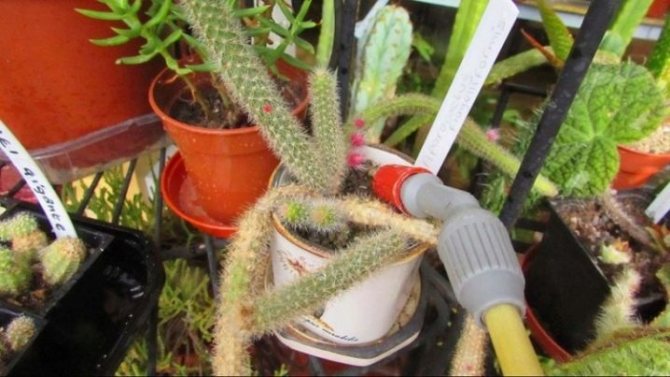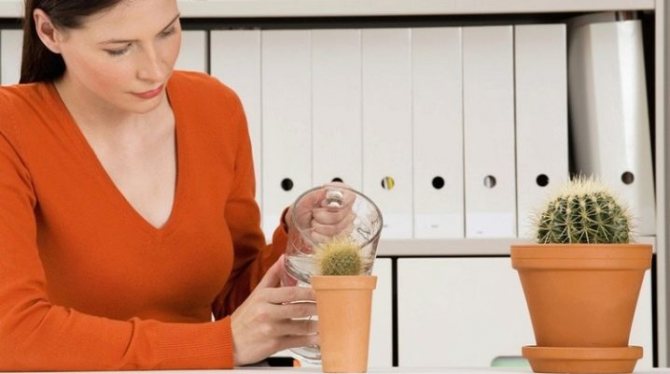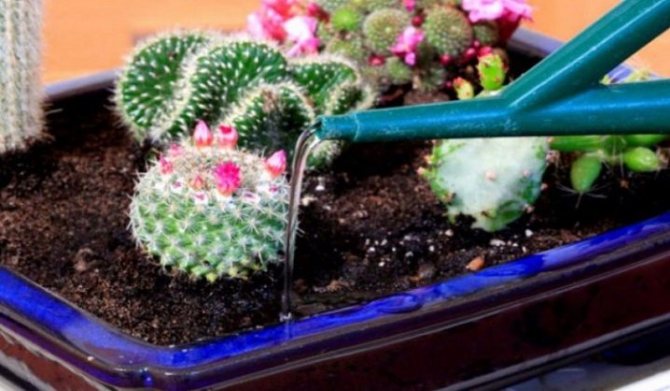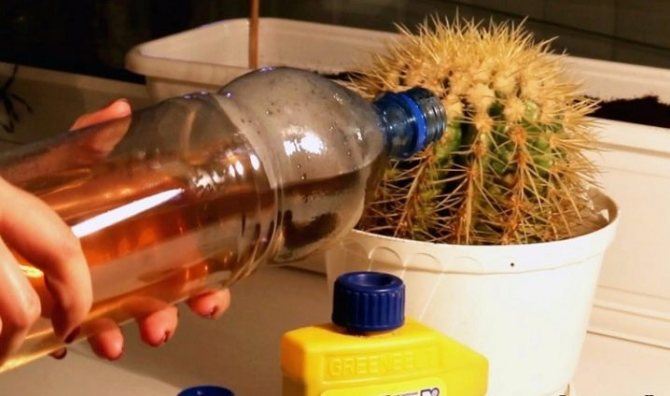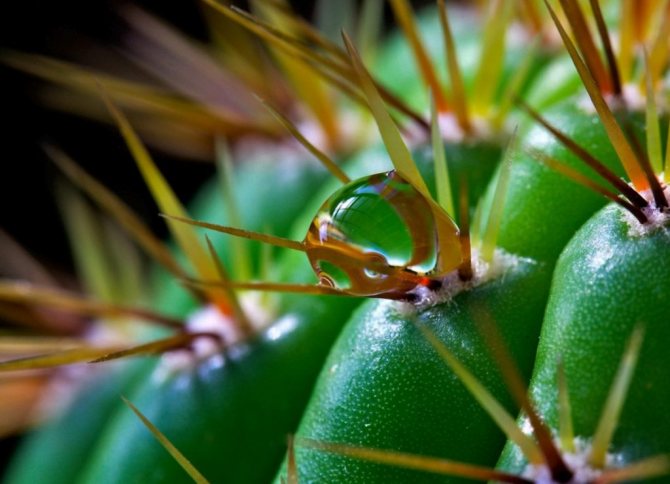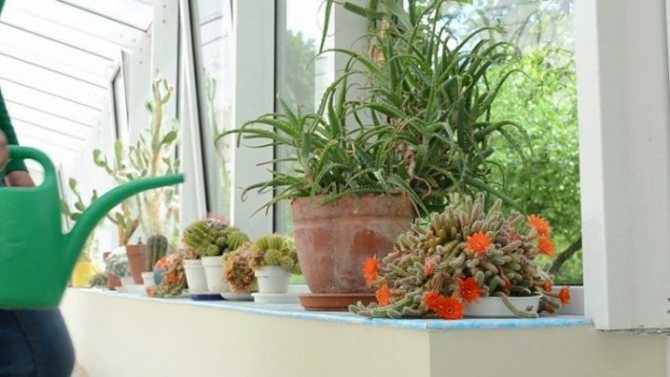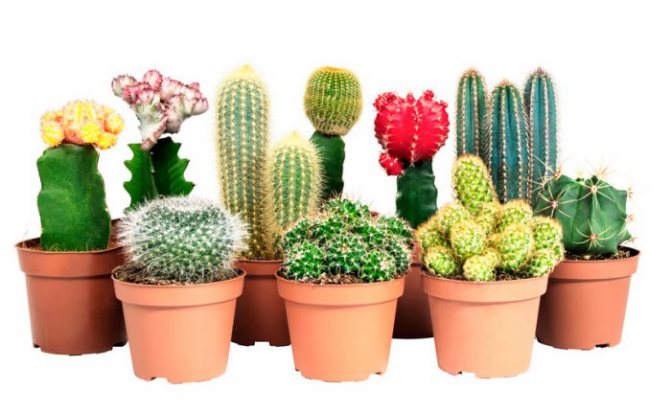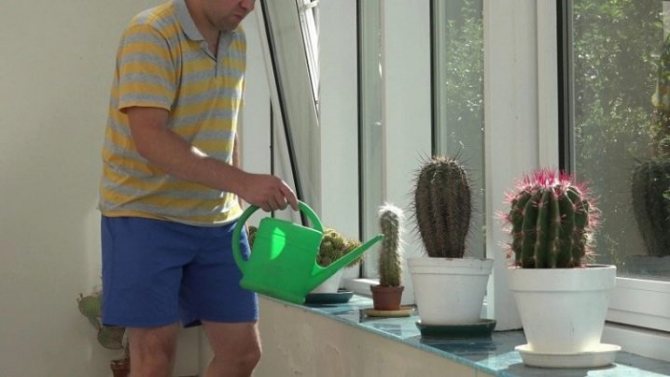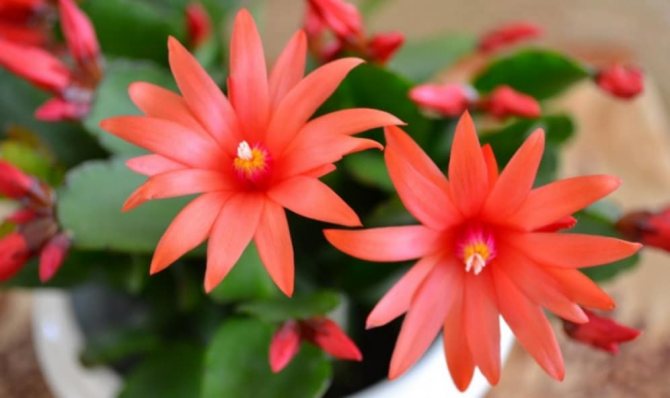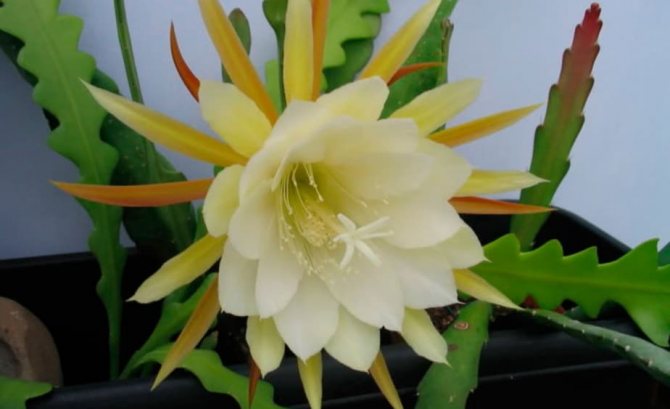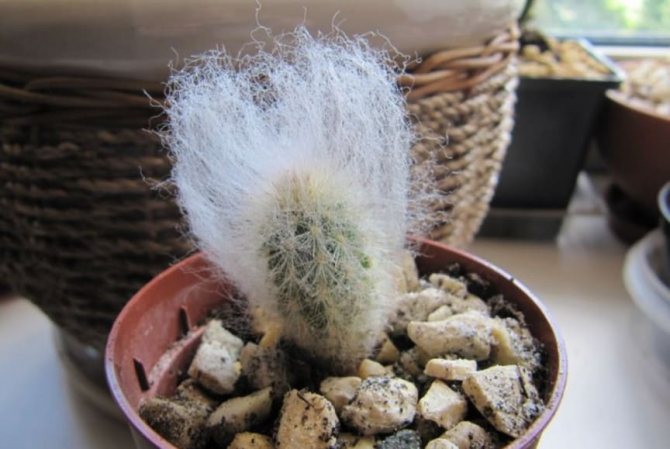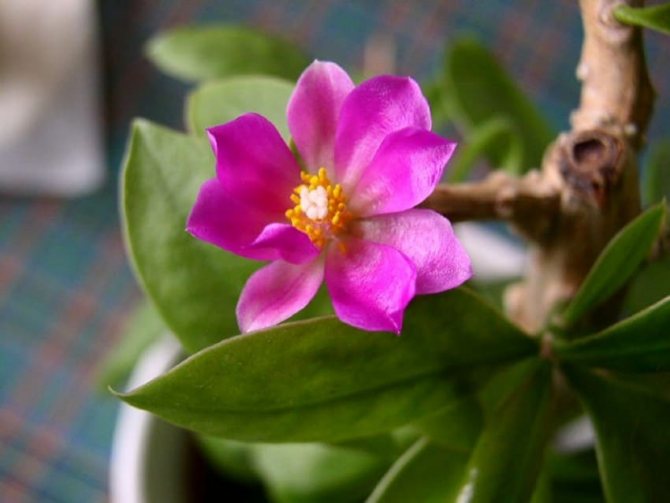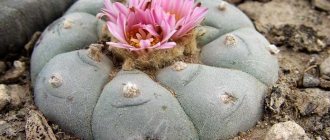The main place of residence of cacti is the desert regions of America, although some types of succulents are found in the tropics and on the coast. Since rains are very rare in deserts, and there is not enough moisture, nature has given these plants the ability to accumulate life-giving liquid in their stems and save it for a long time. This article will discuss the features and rules for watering home cacti.
Watering cacti in winter
How to care for a cactus in winter was very well told by Maria (Colleague), a forum participant and specialist in cactus cultivation:
Now, when the cacti are sleeping, the issue of watering is very important. As for the technique: you can take a cocktail tube, dip it into the water, close the upper hole with your finger. We lower the open end of the tube into the pot - away from the root collar. Let go of the finger, the water is poured into the pot. So you can selectively, gently water your cacti during the winter. And a little educational program on watering some types of cacti:
|
|
* watering once a month - literally a teaspoon of water away from the root collar - most cacti do not like and do not tolerate the moisture of the root collar, especially in winter, so when watering from above, make sure that water penetrates into the substrate near the walls of the pot. The table is supplemented and corrected by Natali
For more details on the conditions of keeping cacti, see the article by Irina Bagdasarova Cacti. Brief requirements for soil, temperature, lighting.
Read about caring for a cactus at home: lighting, temperature, soil. We consider in detail how to properly water a cactus in spring, summer, autumn and winter (frequency, methods, water for irrigation).
We also describe what fertilizer is needed for cacti, how to transplant, propagate and grow from seeds at home.
Lighting and temperature for a cactus at home
Caring for a cactus at home is quite simple, as the plants themselves are hardy and unpretentious, but knowledge, skills and attentiveness are still required from us.
Lighting and temperature
Light for cacti is very important for development and growth. They like a lot of sunlight (light-loving), so it is better to place them on the south window, if there is none, then on the west or east.
If the cactus grows on the north side, then it needs additional lighting. An insufficient amount of light manifests itself in a thinning of the apex.
- There are no shade-loving plant species, there are only some shade-tolerant ones.
Summer
Bright sun rays in summer rarely harm the flower; only forest species (ripsalis, etc.) recommend shading.
It is useful to ventilate and expose cacti to fresh air (balcony, veranda), but at the same time protect from dust, rain and wind. Cover them with plastic wrap in rainy weather.
By gradually increasing the airing time, the plants adapt to the outdoors and after 2-3 weeks they can be kept outdoors around the clock, until the end of summer.
Night temperature drops strengthen the skin of the cactus, endow it with shiny thorns, allow them to winter more easily, increase disease resistance and improve flowering. Drafts are the main danger.
Winter
In winter, cacti are difficult to tolerate dry air with high temperatures. Place the flower on the windowsill farther from the battery and closer to the glass (no touching!).
- The optimum temperature for cacti will be 16-24 ° С.It is better for cacti to winter at 10-15 ° С and without drafts. Epiphytic species need a warmer place.
Most species of such genera have more chances to bloom during a warm winter: Aporocactus, Gymnocalycium, Melocactus, Notocactus, Parodia and Rhipsalis.
The rest of the species need a cold wintering (8-13 ° C) for flowering. In room conditions, it is difficult to achieve such a temperature, because heating radiators are located next to the windowsill.
Therefore, flower growers either carry plants to a cool balcony, loggia, or protect them from a heat source using partitions made of thick cardboard, foam and other materials at hand.
IMPORTANT: The cactus does not like frequent rearrangements. Do not turn it the other side to the light (put a mark on the pot so as not to be mistaken), for a smoother growth - it is absolutely impossible to do this during budding and the beginning of flowering!
SEE ALSO:
1. HOW IMPORTANT IS THE CORRECT LIGHTING FOR PLANTS?
2. WHICH LAMPS IS BETTER FOR LIGHTING HOME FLOWERS?
3. WHAT TEMPERATURE REGIME WILL BE OPTIMAL IN HOME CONDITIONS?
Such a lonely and such a beautiful cactus ...
Helpful hints
Cactus plants are strikingly different from more familiar indoor flowers, and in order to properly water a cactus, you should know how to do it so as not to be mistaken:
- Many cacti like to be outdoors in warm weather. They should be equipped with a rain canopy.
- Moisture must be introduced into the soil, avoiding its contact with the aerial parts of the succulent.
- Waterlogging of the soil is most dangerous at low air temperatures, as well as with a lack of natural light; in such conditions, flowers often attack various rot.
- Water that accumulates in the sump after watering or later needs to be removed.
- For cacti, the bottom irrigation method is also suitable - "through the pan", but in this case it is difficult to determine the amount of introduced moisture.
- In summer, it is better to water succulents in the evening, at low air temperatures - in the morning.
- If the weather is cloudy, rainy, then it is advisable not to moisturize the cactus bud.
- After transplanting, the plant is placed for several days away from direct sunlight and is not watered; it is advisable not to disturb it during adaptation.
- Fertilize cactus plants during active growth using liquid mineral fertilizing. They are introduced into the soil after watering or together with it, so that the fertilizer does not burn the aboveground and underground parts of the flower.
Flowering cacti during the budding period require a delicate attitude. If at this time you turn the pot with the plant, rearrange or pour the soil, then the pet will get rid of the buds or they will turn into processes.When the flowers bloom, it is important to provide it with the necessary moisture, but without fanaticism.
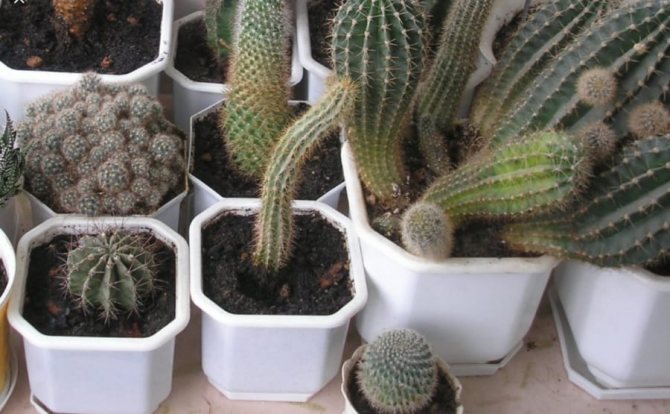
How to properly water a cactus at home?
Many growers think about how to water a cactus at home and do it right, because watering plays a very important role in the life of a plant.
For watering cacti, it is recommended to use only soft water. You can water them from above into a pot or into a pan - both methods are correct.
Next, we will tell you in detail about watering the plant at home in all seasons.
How often should a cactus be watered? (winter spring Summer Autumn)
Winter
From November to early March, cacti have a dormant period. At this time, the need for moisture is minimal. In order for the cactus to bloom, you need a low temperature and poor watering.
Large and old specimens are watered once every 4 weeks, and small ones more often - once every 14-20 days with a small amount of water (literally one or two tablespoon). You can spray cacti with warm water once a month - before budding and flowering and water once a month.
During the period of budding and the beginning of flowering, epiphytic cacti and prickly pears can be watered, and Cereus are only sprayed with warm water. Waterlogging leads to the fact that from the buds instead of flowers "babies" grow.
- Many flower growers recommend not watering cacti at all in winter and get excellent results of flowering and further development.
The editorial board of the "Holiday of Flowers" magazine reminds that you need to remember about the specific features. If in doubt, water your cacti in the winter using the gentle regimen described above.
Spring
As the temperature rises and the amount of light increases, cacti "come to life" and the need for water gradually increases.
Watering cacti in the spring is recommended to start after the start of growth (young green skin at the top): March - once every 12-16 days, April - once every 8-12 days, May - once every 5-7 days.
Spray about once every 14-20 days. The terms are approximate for central Russia, the principle is the same: the warmer and lighter, the more often.
Summer
In summer, cacti are watered most often, as the maximum growth and intensive development of the plant occurs.
How often should a cactus be watered in summer?
Most species recommend watering in the morning every day or every other day with a little water. An exception is cloudy weather; watering is not required on such a day.
Fall
In the fall, the cactus is gradually prepared for a dormant period and subsequent flowering. They are watered less and less along with a decrease in temperature: September - once every 5-7 days, October - once every 10-14 days.
From November to March (dormant period), once every 25-30 days, a small amount.
General rule: watering cacti is better less often and less than more and more.
WE RECOMMEND TO FIND OUT:
1. IRRIGATION OF ROOM PLANTS FROM "A" to "Z" - OVERVIEW!
2. WHAT IS THE BEST WAY TO WATER HOME FLOWERS?
3. WHAT WATER DO HOUSE PLANTS NEED AND HOW TO PREPARE IT?
4. HOW TO WATER ROOM FLOWERS DURING VACATION?
Water quality
Even inexperienced flower growers know that indoor flowers should be watered with water at room temperature, purified from harmful impurities. These are the basic requirements for water for irrigation of any ornamental plants. Cacti, on the other hand, like water with the following parameters: soft, acidic or slightly acidic, without lime.
The appearance of whitish spots on succulents, especially on their lower part, is an alarming sign. This is most likely due to the fact that the plant is watered with water with a high lime content. The affected areas not only spoil the appearance of the flower, but also disrupt the respiratory processes.
If the water is too hard, you can soften it by adding a cloth bag of charcoal or a few activated charcoal tablets while standing.
It is important! Cold water is harmful to all indoor flowers, especially succulents, which have a shallow root system.Watering with such moisture causes shock at the roots, which leads to a slowdown in the growth of a cactus or even its death.
You can water the flowers with rain or melt water, this is the best option, provided that moisture is collected far from various industries and transport routes.
Top dressing and fertilizers
The use of fertilizers for cacti is covered in different ways in the literature and is accompanied by a long debate. We can say for sure that cacti need a small amount of nitrogen and its excess leads to improper plant development.
Therefore, organic fertilizers are not recommended for use, except for small doses for rapidly growing and epiphytic species.
Cacti need calcium and phosphorus, and potassium during the flowering period. Therefore, it is better to use a special fertilizer for cacti and succulents.
Fertilizer "Cactus" with a balanced composition of micro- and macroelements is quite popular. Release form - 0.5 liter bottle.
Universal feeding period: from April to early September every two weeks.
ATTENTION!
- The growth and flowering period of cacti often does not coincide, so do not feed in winter when the plant is blooming. For these species, you can slightly increase watering.
- Do not apply fertilizer to cacti after or before transplanting.
CREATE KNOWLEDGE:
1. WHAT ARE THE TYPES OF FERTILIZERS AND HOW TO USE THEM?
2. WHAT HOME AND NATURAL FERTILIZERS ARE THE MOST EFFECTIVE?
3. HOW TO FEED ROOM PLANTS CORRECTLY?
Different types of cacti
What determines the frequency of watering
Most cactus species are not recommended to be watered frequently. Such care can greatly harm them, because the abundance of moisture squeezes the air out of the ground and literally strangles the roots. As a result, rot and other diseases begin to develop, pests may appear and the culture will begin to die off.
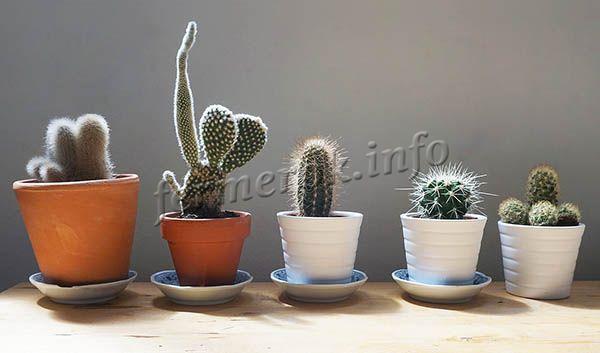

The soil dries faster in a ceramic pot than in a glass or plastic pot.
Depending on some factors, the features of watering a cactus can be very different.
- Plant type. Different types of cacti require specific watering regimes. There are types of cacti that need a lot of water for normal development (Decembrist, Epiphyllum, Ripsalidopsis). But cacti like mammillaria, hymnocalycium, lobivia do not tolerate an abundance of moisture in a pot.
- How to water a cactus depends largely on where it is located, namely on the lighting. For example, if it is on the sunny side, more watering will be required, because the earth will dry out faster.
- The higher the temperature and the lower the humidity, the faster the water evaporates and the more liquid the plant needs. If the temperature on the thermometer is about + 5 ... + 10 degrees, then watering is not recommended at all!
- In a ceramic pot, the soil dries out faster than in a glass or plastic pot, so more watering is needed.
- During an active growing season, the plant needs more water, and during rest, watering is minimized.
Transplanting a cactus at home + soil
It is best to replant the cactus from late March to late May. Young plants are transplanted every year, and adults (from 4 years old) every 2-3 years before the start of active vegetation (March).
Transplant plan
- Do not water the flower 3-4 days before transplanting for the convenience of separating the soil from the roots.
- At the bottom of the pot, be sure to use a drainage layer (2-4 cm) - stagnant water is contraindicated for cacti (especially for epiphytes). Fill the holes with shards, pour fine gravel, expanded clay, charcoal or coarse sand on top.
- Depending on the depth of the pot and the length of the roots, a 2-4 cm layer of soil mixture is poured on top of the drainage. The plant is placed on the ground and the roots are straightened, while the base of the cactus should be in line with the edge of the pot.
- After that, they begin to fall asleep around the substrate to the root collar, periodically shaking the pot and compacting the soil. A 1 cm layer of sand can be poured on top of the substrate.
- The first 3-4 days after transplanting a cactus, do not water it or place it in direct sunlight.
How to choose a cactus pot?
The main thing is that the volume of the cactus pot is not much larger than the volume in the expanded form of the root system and takes into account the peculiarities of the species.
Example: Ariocarpus is suitable for a deeper than a wide pot, and for mammillaria many children appear and many plants grow in one dish over time.
For specimens with short and branched roots, a low and wide pot is selected, for a cactus with long roots or a rod type, a deeper and narrower one is suitable.
The form... Between the square and round shape of the container, it is better to choose the second option. However, if you have a large number of cacti or are constantly expanding your collection, then square or rectangular pots save space on the windowsill and are easier to carry on a tray to another location.
Material. Both plastic and clay are suitable. Cacti are not picky about the material, they do not recommend using only a metal container.
Soil mix
The soil for cacti differs depending on its type, age, etc. Experienced florists can find various examples of the substrate.
The general features are as follows: the soil for a cactus should be loose, slightly acidic (pH = 4.5 - 6), light and nutritious (the ratio of minerals is different).
A typical DIY potting mix would be leafy soil and river sand (1: 1) + some peat (acidity) and powder with small pieces of hardwood charcoal.
Young plants and seedlings need a looser and more nutritious potting mix (increase the amount of leafy soil). A denser substrate is suitable for adult plants; for this, clay-sod soil is added to it.
- Tricks: for rapidly growing species, it is useful to add humus to the substrate. For cacti with a lot of thorns, it is useful to add crushed eggshells to the mixture.
HELPFUL INFORMATION:
1. SECRETS OF CORRECT TRANSPORTATION OF INDOOR PLANTS!
2. WHAT SOIL MIX COMPONENTS HOW TO USE?
3. WHEN TO REPLAY ROOM FLOWERS ON THE LUNAR CALENDAR?
What to water
For watering cacti, ordinary chlorinated tap water will not work. You need clean and soft water without salts, chlorine and impurities. Rainwater is perfect, but it needs to be further processed before use. Otherwise, you run the risk of introducing various infections into the soil in addition to the water itself. Hard water for irrigation is a dullness of plant growth and the appearance of all kinds of diseases, which can be caused by alkalization of the soil. At the same time, succulents become very weak and become vulnerable to infectious and fungal diseases. You can reduce the hardness with acetic or nitric acid, which is added at the rate of 2-4 drops per 1 liter of water. Boiling also helps, after which all harmful bacteria die.
Important! People living in villages often use well water for watering cacti. This is wrong, since such water contains harmful substances for the plant. She is also very tough.
How do cacti breed?
The cactus can be propagated vegetatively or using seeds.
How to grow cacti from seeds at home?
To grow a cactus from seeds, it is better to use seeds from a store, since at home, due to over-pollination, related specimens are crossed.
In order to grow cacti from seeds at home, you need to be patient and work hard.
- Cactus seeds are disinfected in a solution with manganese.
- The substrate is poured in a layer of 1-2 cm, moistened and seeds are laid out on top. Then they are covered with a film or wall.
- Air cactus seeds 1-2 times a day and keep the soil mixture moist.
- After the appearance of the first thorns (depending on the type, seeds can germinate from 2-3 days to 2-3 months), the sprouts are transplanted into containers with a more nutritious substrate than in adult cacti.
- When the seedlings are about three months old, they are cared for in the same way as adult cacti.
- Advice: cactus seeds are best planted so that they germinate in March-April.
Propagation of cacti by cuttings
It is more convenient and efficient to propagate cacti by cuttings. Many species have lateral babies with rudimentary roots that can be easily detached and can be immediately planted in the potting mix.
Cacti that do not have children are a little more difficult to propagate:
1.Cut off a healthy shoot or stem section.
2. The cut site is dried in the sun for 3-4 days and then planted in a moist soil mixture.
How to plant cacti correctly? Video
RECOMMENDATIONS:
1. REPRODUCTION OF ROOM FLOWERS - OVERVIEW!
2. VEGETATIVE REPRODUCTION OF HOUSEHOLD PLANTS IN DETAILS!
About air humidity
Succulents are very hardy plants, as they can perfectly tolerate hot and dry air. But at the same time, most of the cacti are refreshed with morning dew or evening fog. Spraying every day has a positive effect on growth. To do this, you need to use warm water, from 30 to 40 degrees. In sunny weather, spraying is carried out before sunlight hits the plant, and in autumn cold weather it is better not to spray at all. Of course, there is an exception among cacti, which can be given a generous shower to remove cobwebs and dust. These are Epiphyllum, Ripsalis and others. Excess moisture will not harm them in any way, but will only benefit.


